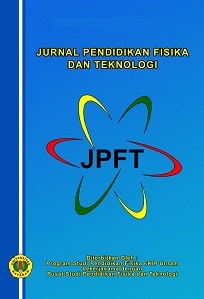Pengaruh Model Pembelajaran Generatif Berbantuan Media Laboratorium Virtual Terhadap Penguasaan Konsep Fisika Siswa pada Materi Momentum dan Impuls
DOI:
10.29303/jpft.v2i2.290Published:
2017-04-22Issue:
Vol. 2 No. 2 (2016): AprilKeywords:
generative-based learning, virtual laboratory media, concept masteryArticles
Downloads
How to Cite
Downloads
Metrics
Abstract
This ââ¬Ånon-equivalent control group designââ¬Â quasi experimental research was purposed to identify the effect of generative-based learning model using virtual laboratory media towards the studentsââ¬â¢ concept mastery and creativity in physics. The population of this research is all 173 students of X grade in SMK Negeri 7 Mataram. The X grade students of Teknik Komputer Jaringan A (TKJ-A) department was determined as the experimental group and the X grade students of Teknik Komputer Jaringan B (TKJ-B) department was the control group. The way of collecting data for the concept mastery was done by using multiple choice test. The result revealed that the mean score of the post-test for the concept mastery was 43 for the experimental group with the highest score 56. Meanwhile the mean score of the control group was 36 with the highest score 52. The research hypothesis was tested using t-test pooled variances. The result showed that the value of ttab is higher than tarith the value is 3,42 > 2,00 for the concept mastery. As the conclusion, this research showed that there was an effect towards the experimental group studentsââ¬â¢ concept mastery and creativity in physics which was treated using generative-based learning model using virtual laboratory media.
References
Gunawan. 2015. Model Pembelajaran Sains Berbasis ICT. Mataram: FKIP UNRAM.
Wena, M. 2014. Strategi Pembelajaran Inovatif Kontemporer. Jakarta: Bumi Aksara.
Fabian, K., Topping, K. J., Barron, I. G., and Chuah, K. M. 2016. Mobile Technology and Mathematics: Effects on Studentsââ¬â¢ Attitudes, Engagement, and Achievement. J. Comput. Educ. 3(1): 77-104.
Lusiana., Hartono, Y., dan Saleh, T. 2009. Penerapan Model Pembelajaran Generatif (Mpg) untuk Pelajaran Matematika di Kelas X SMAN 8 Palembang. Jurnal Pendidikan Matematika. 3 (2): 30-31.
Ying, H.W., Huang, I., & Jen, G.H.. 2016. Comparison of the effects of project-based computer programming activities between mathematics-gifted students and average students. J. Compt. Edu. 3(1): 33ââ¬â45.
Dahar, R.W. 1996. Teori-teori Belajar. Bandung: Erlangga.
Ausubel, D.P., Novak, J.D., and Hanesian, H. 1978. Educational Psychology: A Cognitive View (2 nd.ed). New York: Holt, Rinehart and Winston.
Tan, W.C., Aris, B., and Abu, S. 2006. GLOTT Model: A pedagogically-enriched design framwork of learning environment to improve higher order thinking skills. AACE Journal, 14(2): 139-153.
Pietzner, V. 2014. Computer-Based Learning in Chemistry Classes. Eurasia Journal of Mathematics, Science & Technology Education. 10(4): 297-311.
Ulusoy, F. M., and Onen, A. S. 2014. A Research on the Generative Learning Model Supported by Context-Based Learning. Eurasia Journal of Mathematics, Science & Technology Education. 10(6): 537-546.
Juani, A., Salsabila, E., dan Irawan, B. 2014. Perbandingan Kemampuan Penalaran Matematika antara Siswa yang diajar Menggunakan Model Pembelajaran Generatif dan Model Pembelajaran Matematika Knisley (Mpmk) Pada SMKN 26 Jakarta. JMAP. 13 (1 ): 48.
License
Authors who publish with Jurnal Pendidikan Fisika dan Teknologi (JPFT) agree to the following terms:
- Authors retain copyright and grant the journal right of first publication with the work simultaneously licensed under a Creative Commons Attribution License 4.0 International License (CC-BY-SA License). This license allows authors to use all articles, data sets, graphics, and appendices in data mining applications, search engines, web sites, blogs, and other platforms by providing an appropriate reference. The journal allows the author(s) to hold the copyright without restrictions and will retain publishing rights without restrictions.
- Authors are able to enter into separate, additional contractual arrangements for the non-exclusive distribution of the journal's published version of the work (e.g., post it to an institutional repository or publish it in a book), with an acknowledgement of its initial publication in Jurnal Pendidikan Fisika dan Teknologi (JPFT).
- Authors are permitted and encouraged to post their work online (e.g., in institutional repositories or on their website) prior to and during the submission process, as it can lead to productive exchanges, as well as earlier and greater citation of published work (See The Effect of Open Access).











